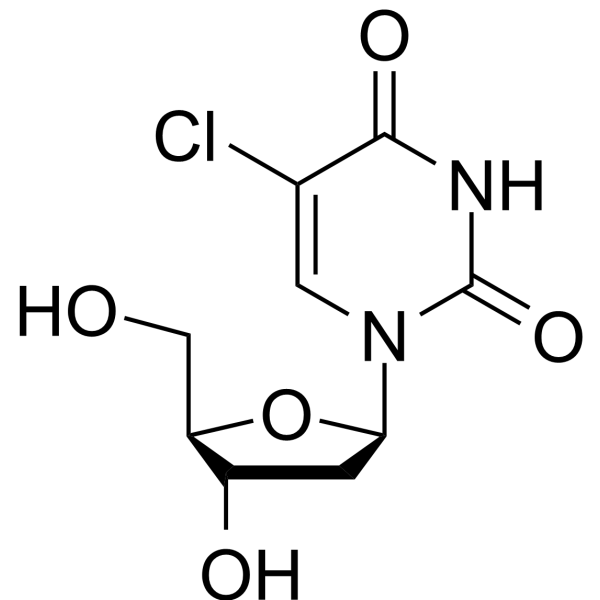
5-Chloro-2-deoxyuridine
CAS No. 50-90-8
5-Chloro-2-deoxyuridine( 5-Chlorodeoxyuridine | CldU )
Catalog No. M27059 CAS No. 50-90-8
5-Chloro-2'-deoxyuridine is a thymine analog. It can be used to study the potential of hypochlorous acid damage to DNA and DNA precursors.
Purity : >98% (HPLC)
 COA
COA
 Datasheet
Datasheet
 HNMR
HNMR
 HPLC
HPLC
 MSDS
MSDS
 Handing Instructions
Handing Instructions
| Size | Price / USD | Stock | Quantity |
| 5MG | 49 | In Stock |


|
| 100MG | Get Quote | In Stock |


|
| 200MG | Get Quote | In Stock |


|
| 500MG | Get Quote | In Stock |


|
| 1G | Get Quote | In Stock |


|
Biological Information
-
Product Name5-Chloro-2-deoxyuridine
-
NoteResearch use only, not for human use.
-
Brief Description5-Chloro-2'-deoxyuridine is a thymine analog. It can be used to study the potential of hypochlorous acid damage to DNA and DNA precursors.
-
Description5-Chloro-2'-deoxyuridine is a thymine analog. It can be used to study the potential of hypochlorous acid damage to DNA and DNA precursors.(In Vitro):When 5-Chloro-2’-deoxyuridine (ClDU) is placed into the tissue culture medium, mammalian cells incorporate the analog into DNA. It is observed that a 10 μM concentration of 5-Chloro-2’-deoxyuridine in the media does not alter cell division kinetics. Previously it has been shown that 5-Chloro-2’-deoxyuridine is metabolized and incorporated into DNA using antibodies that bind selectively to DNA containing halogenated bases. In the studies reported here, 5-Chloro-2’-deoxyuridine is more similar to BrdU in acting as a T analog. The toxicity of 5-Chloro-2’-deoxyuridine could in part be attributed to inhibition of thymidylate synthase .
-
In VitroWhen 5-Chloro-2’-deoxyuridine (ClDU) is placed into tissue culture medium, mammalian cells incorporate the analog into DNA. It is observed that 10 μM concentration of 5-Chloro-2’-deoxyuridine in the media does not alter cell division kinetics. Previously it has been shown that 5-Chloro-2’-deoxyuridine is metabolized and incorporated into DNA using antibodies that bind selectively to DNA containing halogenated bases. In the studies reported here, 5-Chloro-2’-deoxyuridine is more similar to BrdU in acting as a T analog. The toxicity of 5-Chloro-2’-deoxyuridine could in part be attributed to inhibition of thymidylate synthase.
-
In Vivo——
-
Synonyms5-Chlorodeoxyuridine | CldU
-
PathwayOthers
-
TargetOther Targets
-
RecptorTRPM4
-
Research Area——
-
Indication——
Chemical Information
-
CAS Number50-90-8
-
Formula Weight262.65
-
Molecular FormulaC9H11ClN2O5
-
Purity>98% (HPLC)
-
SolubilityIn Vitro:?DMSO : 250 mg/mL (951.84 mM)
-
SMILESOC[C@H]1O[C@H](C[C@@H]1O)n1cc(Cl)c(=O)[nH]c1=O
-
Chemical Name——
Shipping & Storage Information
-
Storage(-20℃)
-
ShippingWith Ice Pack
-
Stability≥ 2 years
Reference
1.Hilmar BADING, et al. Novel means to modulate nmda receptor-mediated toxicity. WO2020078554A1
molnova catalog



related products
-
HMN-176
HMN-176 is a stilbene derivative which inhibits mitosis, interfering with polo-like kinase-1 (plk1).
-
Oleclumab
Oleclumab (MEDI9447) is a human anti-CD73 monoclonal antibody with anticancer activity that inhibits the extracellular enzyme CD73 nucleic acid exonuclease activity, inhibits the adenosine pathway, and can be used for the study of metastatic desmoplasia-resistant prostate cancer.
-
NH2-PEG2-C6-Cl hydro...
NH2-PEG2-C6-Cl hydrochloride is a PROTAC linker belonging to the PEG class and can be used to synthesize PROTAC molecules.



 Cart
Cart
 sales@molnova.com
sales@molnova.com


